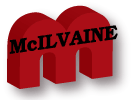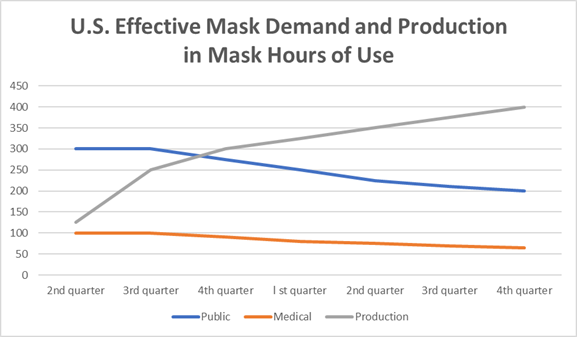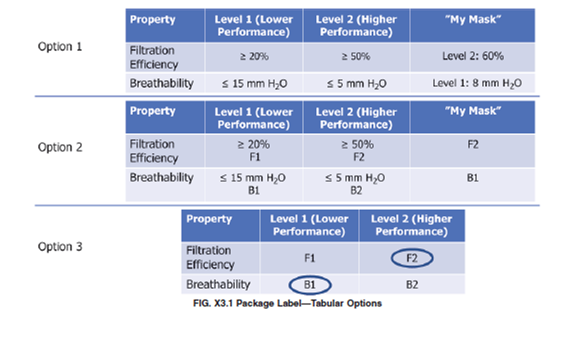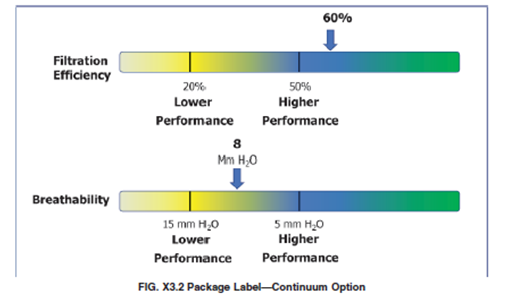
CATER Mask
Decisions
February 16, 2021
Mask Strategy with the Most Advantages for the
U.S.
Tighter Fitting Surgical Mask, Brace, N95 or
CATER
ASTM Mask Standard
has Now Been Published
Fit, Comfort, and
Attractiveness Need to be Evaluated
Qualitatively
The Pandemic Could Last Seven Years According to
Bloomberg
___________________________________________________________________________
Mask Strategy with the Most Advantages for the
U.S.
The U.S. is shaping its mask strategy. In the
Alert yesterday we proposed what could be called
the “incidentally Humanitarian U.S.
Mask Strategy.
It is a two stage program. In the first stage
U.S. mask suppliers are encouraged to greatly
increase production of effective masks to meet
the near term needs. As the need wanes in the
U.S. the government would issue coupons to poor
countries and allow them to obtain masks from
U.S. suppliers.
Why is it in the self-interest of the U.S to pay
for masks in poor countries for the next five
years?
1.
A long term market is created for the mask and
media suppliers. They can switch from domestic
sales to exports as the domestic market
subsides.
2.
The improved economies and supply of goods to
the U.S and purchase of goods from the U.S. by
poorer countries will more than offset any mask
subsidies.
3.
New variants and even strains of the virus will
be prevented from being transmitted from poor to
wealthy countries.
4.
Wealthy countries need to be prepared for the
next pandemic with sufficient supply capacity.
5.
Enhance U.S. image.
One of the problems in creating a national
stockpile of masks for use in a future pandemic
is that masks deteriorate over time. A second
problem is that it would be prohibitively
expensive to invest in idle reserve
capacity. 3M thought they had made a
sufficient investment but did not conceive of a
demand at the current level.
The way to protect the U.S. from future
pandemics is create a robust long term mask
market including:
·
supply masks to the poorer countries to fight
the pandemic
·
promote the use of masks to protect from air
pollution, influenza, wildfires, and other
airborne contaminants
The U.S. short term need in mask hours is three
times greater than the medical need. So we set
up a chart where the present medical demand =
100.
The present public demand is set at 300 .
total demand is 400.

Present U.S. production for qualified public and
medical masks is only slightly above the medical
mask production and less than 30% of the total
demand.
By the 1st quarter 2022 production
exceeds demand by 5. So a small amount could be
exported.
By the 4th quarter 2022
production exceeds demand by 135. So this amount
could be exported. It is slightly more than the
present U.S. production.
By the end of 2022 U.S production would be close
to four times greater than at present. There
will be a continuing supply of coupons to poorer
countries who will not achieve herd immunity
until 2024-2027.
The result will be a very large market for U.S.
made masks which will continue for at least the
next four to five years.
Tighter Fitting Surgical Mask, Brace, N95 or
CATER
There are no longer five options for public
masks. Inefficient loose fitting cloth masks
will quickly be unsalable now that the ASTM
standards have been published. This leaves four
choices.
|
Option |
Challenges |
|
Tighter fitting
Surgical |
Achieving tight
fit |
|
Surgical mask
with brace |
Achieving tight
fit with comfort |
|
N95 |
Availability and
individual fit |
|
CATER |
Availability,
life, and cost |
N95 Option
McIlvaine has used the N95 as the yardstick by
which to measure the others. But there are
negatives to the N95 as covered in a JAMA
article.
https://jamanetwork.com/journals/jamainternalmedicine/fullarticle/2769441
Here are excerpts from the report
“Importantly, the
effectiveness of any mask also depends heavily
on its real-world use; variability in mask
filtration during clinical care may fluctuate
more by mask adherence and fit than by marginal
differences in laboratory-based filtration
efficiency. In practicality, when worn properly,
N95 masks are suffocating, uncomfortable, and
difficult to tolerate for long durations. Best
practices for N95 use require intermittent,
individualized fit testing and a seal check on
donning. Mask fit varies by facial shape and
body habitus, and thus, once fit tested,
ensuring fidelity to the same manufacturer and
size is essential. Filtration efficiency of an
N95 mask can also be compromised by even small
amounts of facial hair in the area of the seal.
Prolonged use of tightly fitting masks may
result in facial bruising and abrasions,
“Costs have been a major challenge in
procurement of adequate mask supply, with prices
increasing in some cases up to 30- to 100-fold.7 Outside
of pandemic conditions, surgical and N95 masks
generally cost approximately $0.08 and $0.50
each, respectively. Standard pricing for KN95
masks, which are generally not sold in the
United States, is unavailable, but they have
been sold during the crisis from $2 to $4 per
mask”.
CATER Mask Option
These
masks have been extensively covered in
the Alerts. They have all the advantages except
availability and cost. It is likely that higher
income individuals will choose them despite
cost.
Surgical Mask with
Brace
These have been covered in a number of Alerts.
When you search under the key word
“brace” you access 20 articles including
1. McIlvaine
Coronavirus Market Alert
... ,
Efficient Masks Details on Mask Options are
Available from Fix the Mask Essential Mask Brace is
Effective and Inexpensive University of Iowa
Researchers Find That a DIY Mask Brace is ...
2. McIlvaine
Coronavirus Market Alert
... masks
is up to 90 days. A $2 upgraded surgical mask
with a brace might
have an FFE above 85% . The brace has
potentially 1 year of ...
Tighter fitting
surgical masks
In the February 3 Alert
we wrote this about the TMS masks, “The
general Consumer Series single-use face masks
are designed to provide enhanced coverage with a
more comfortable fit. They are wider than the
average mask, reducing the gap between the edge
of the mask and the ears. The nose bridge is
built with higher ductility, allowing it to bend
more easily and stay in place without
discomfort. The ear loops on their masks are
created with a thicker, more comfortable
material that has been tested to stretch to
two-and-a-half times the original length without
losing elasticity.”
Comfort and attractiveness are independent
variables but efficiency of virus removal is a
combination of media capture and limitation of
in leakage. Furthermore this in leakage is a
function of the way the mask is worn and by
whom.
Many cloth masks have fitted filter efficiency
(FFE) ratings which are below 20%. A poorly
fitted N95 might have an FFE below 70%.
A loose fitting surgical mask could have
an FFE below 60%. A poorly fitting CATER mask
can
have an FFE below 70%.
The big difference between the four options is
the in leakage and not the filter media
penetration.
In the case of particulate media capture
the differences are all within a 10% range. The
in leakage can be a difference of 40%. So the
choice of mask types is highly dependent on the
fit.
ASTM Mask Standard
has Now Been Published
The ASTM standards have now been published and
are likely to completely change the way masks
are selected.
the fact that a label with the following
information on it will be displayed with each
mask is very powerful.
In the
example a mask with 60% filtration
efficiency is labeled both to show that it meets
the standard but also how it is better than the
minimum. The example of sunscreen has been used
to illustrate the advantage of showing higher
performance.

There is also a graphic option which shows the
range and the performance of the specific mask.

In order for manufacturers and brands to say
their face mask meets ASTM’s standard, they have
to prove it. Here’s how it works: Brands and
mask makers are required to test their face
coverings in accredited labs. The tests certify
that the masks adhere to ASTM’s guidelines.
Manufacturers also have to complete a conformity
assessment indicating that face coverings
labelled as ASTM-compliant have met all of the
requirements of the standard, including design
criteria, performance criteria, test methods,
labelling and user information.
One area which needs industry input is fit or in
leakage.
Here is what is in the standard relative
to fitness.
“Design criteria include
setting minimum areas of face coverage over the
wearer’s nose and mouth, prohibiting open vents
or valves, requiring a means for retaining the
barrier face covering on the wearer’s head, and
providing a representation of product sizing.
Manufacturers are further required to perform a
design analysis for assessing leakage of exhaled
air from the barrier face covering.
Manufacturers are permitted to conduct
quantitative testing as specified in this
standard to supplement the design analysis.
NOTE 3—The principal
performance criteria for barrier face covering
determined by testing are sub-micron particle
filtration efficiency and airflow resistance.
Quantitative leakage assessment testing is
optional for information purposes and is not
required. This testing is not likely to be
representative of outward leakage from the
barrier face covering and should not be claimed
to represent the amount of source control
offered by the face covering. Bacterial
filtration efficiency testing is also optional
and not required. It is significantly different
than sub-micron filtration efficiency, and the
results of BFE testing cannot be interchanged or
directly compared. The scope of this standard
does not include accessories to barrier face
coverings.
4.1.3 Sub-micron particulate
filtration efficiency and airflow resistance do
not account for the leakage of air around the
perimeter of the barrier face covering. A
leakage assessment using a design analysis of
the product is required to assess the ability of
the barrier face covering design to provide
appropriate coverage for a range of wearer faces
of different dimensions. The design analysis can
be conducted by the manufacturer in a number of
different ways. The standard also permits the
supplemental use of quantitative information
obtained from a modified form of Test Method
F3407 using test subjects. This test yields a
reportable ratio of outside particulate
concentration to the concentration of particles
in the wearer’s breathing zone. Thus, a leakage
ratio of 1.0 indicates the outside and inside
environments are equal and that particulates
flow through gaps in the barrier face covering
(in addition to any particulates that pass
through the filtration materials of the mask).
Fit (leakage) is a complex
subject and involves facial features and wearing
habits as well as quantitative tests.
It is asking too much of a standard to
rate fit in the same way it does particulate
efficiency.
Fit, Comfort, and
Attractiveness Need to be Evaluated
Qualitatively
The ASTM standards provide a
measurement structure and while not providing a
fit (leakage) standard they do indicate the
importance of a good fit. It is then up to
experts to make comparative leakage assessments.
They in turn need to communicate these findings
to the media.
Let’s use the example of sunscreen and compare
it to masks as rated by Consumers Reports.
For sunscreen “Consumer Reports uses a
testing protocol that is modeled on the one the
Food and Drug Administration (FDA) requires
sunscreen manufacturers to use. But as is the
case with other products we test that have
government or industry standards, we use those
standards as benchmarks and develop our own
methodology to identify differences in
performance and give consumers a comparative
evaluation.
We
test only sunscreens with a listed SPF of at
least 30 and are water-resistant (for 40 or 80
minutes, the two time periods the FDA permits
water-resistance claims for). We buy the
sunscreens for our tests off the shelf, the way
consumers would and use three samples,
preferably with different lot numbers, of each
product.
Each sunscreen is rated on three criteria: SPF,
variation from SPF, and UVA protection. In
addition, CR's trained sensory panel evaluates
the scent and skin feel of the products.”
Can CR do the same type of evaluation on mask
fit? CR
is already anticipating the ASTM
standards and has zeroed in on the importance of
fitness.
CR
advises “ASTM International, an organization
that facilitates the creation of standards for a
wide variety of products, is working on
developing a standard for the design,
performance, and labeling requirements for face
coverings. But until that standard is released,
a few tips can help you figure out how to make
sure you’re adequately protected.
“Wear the most protective mask you possibly can,
every single day,” says James Dickerson, the
chief scientific officer at Consumer Reports.
“Don’t skimp.”
“Here’s what you need to know to upgrade your
mask. “Check the Fit”
“The right fit can go a very long way even with
just a simple cloth mask,” says Monica Gandhi
(who participated in the last McIlvaine mask
webinar). A mask should have a sturdy nose wire,
to help the mask fit the natural contours of
your face.”
“But there are other tweaks you can make to
improve the effectiveness, adds Philip Clapp,
Ph.D., a post-doctoral researcher at the Center
for Environmental Medicine, Asthma, and Lung
Biology at the University of North Carolina at
Chapel Hill and co-author of the December JAMA
study.
“For instance, his study found that simple steps
like tightening ear loops (either by tying them
or fastening them with a claw-type hair clip
placed behind the head) and tucking in side
pleats significantly improved a surgical mask’s
filtration rates. “Anyone can do that in 15
seconds, and it doubles its efficiency,” he
explains.
“The new study from the CDC reinforced Clapp's
findings. It found that a surgical mask with knotted
ear loops that’s tucked in on the sides to
create a tighter fit reduced
exposure for the wearer by 64.5 percent if a
simulated cougher was unmasked, and by 95.9
percent if both the cougher and the receiver
were wearing these modified, snugly fitted
surgical masks.
“To make sure your mask is snug enough, Clapp
advises that you try this simple self-test: Cup
your hands around your mask and see if you can
feel the places where air is escaping. “You also
don’t want to see gaps around your nose, the
sides of your cheeks, or under your chin,” he
says. If you do, you'll want to tighten up”.
“Ultimately you want all the air you inhale and
all the air that you exhale to go through some
sort of filtration device,” says Dickerson. “If
it doesn’t—if it goes out the sides or through a
vent—then you might as well not be wearing a
mask.”
So we have to give Consumer Reports lots
of
credit for being current on both the ASTM
standards and the need for
ratings which are inclusive of all the
important parameters.
So the industry has its work cut out for it.
It has the ASTM standards as a
measurement structure. It now needs to help
experts and media such as Consumers Reports
rate masks holistically and fairly. One of the
tools will be this CTS publication
The Pandemic Could Last Seven Years According to
Bloomberg
When will the pandemic end? It’s the question
hanging over just about everything since
Covid-19 took over the world last year. The
answer can be measured in vaccinations.
Bloomberg has built the biggest database of
Covid-19 shots given around the world, with more
than 119 million doses administered worldwide.
U.S. science officials such as Anthony Fauci
have suggested it will take 70% to 85% coverage
of the population for things to return to
normal. Bloomberg’s Vaccine
Tracker shows that some countries are
making far more rapid progress than others,
using 75% coverage with a two-dose vaccine as a
target.
Israel, the country with the highest vaccination
rate in the world, is headed for 75% coverage in
just two months. The U.S. will get there just in
time to ring in the 2022 New Year (though North
Dakota could get there six months sooner than
Texas). With vaccinations happening more rapidly
in richer Western countries than the rest of the
globe, it will take the world as a whole
seven years at the current pace.
Bloomberg’s calculator provides a snapshot in
time, designed to put today’s vaccination rates
into perspective. It uses the most recent
rolling average of vaccinations, which means
that as vaccination numbers pick up, the time
needed to hit the 75% threshold will fall.
The calculations will be volatile, especially in
the early days of the rollout, and the numbers
can be distorted by temporary disruptions.
